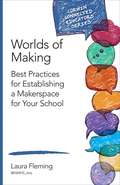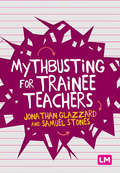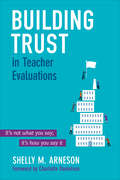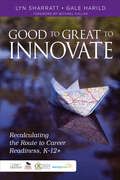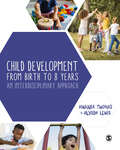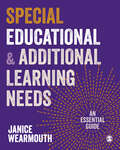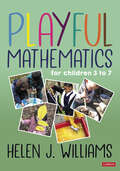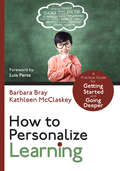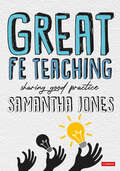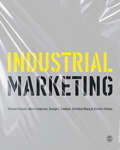- Table View
- List View
Worlds of Making: Best Practices for Establishing a Makerspace for Your School (Corwin Connected Educators Series)
by Laura FlemingMakerspaces: Your questions answered here! Get the nuts and bolts on imagining, planning, creating, and managing a cutting-edge Makerspace for your school community. Nationally recognized expert Laura Fleming provides all the answers in this breakthrough guide. From inception through implementation, you’ll find invaluable guidance for creating a vibrant Makerspace on any budget. Practical strategies and anecdotal examples help you: Create an action plan for your own personalized Makerspace Align activities to standards Showcase student creations Use this must-have guide to painlessly build a robust, unique learning environment that puts learning back in the hands of your students! The Corwin Connected Educators series is your key to unlocking the greatest resource available to all educators: other educators. Being a Connected Educator is more than a set of actions: it’s a belief in the potential of technology to fuel lifelong learning. "Laura Fleming does an exquisite job of creating a guide for all schools to tap into students’ innate desire to create, tinker, invent, and make to learn. Leveraging her experience as a practitioner she provides a compelling, yet simple recipe for any school or educator to transform any space into a makerspace on a shoestring budget. It is time to bring the fun back into learning!" —Eric Sheninger, Corwin Author, Digital Leadership "Fleming provides a concise overview of the Maker Movement as a revolution taking place in learning today. This book makes a case for the importance of creating a culture of innovation and offers practical tips and strategies for those interested in creating their own makerspaces." —Greg Toppo, Education Reporter USA Today
Potential Environmental Effects of Nuclear War
by Division on Earth and Life Studies Board on Atmospheric Sciences and Climate Nuclear and Radiation Studies Board National Academies of Sciences, Engineering, and Medicine Committee on Independent Study on Potential Environmental Effects of Nuclear WarIn response to the buildup of U.S. and Russian nuclear arsenals during the Cold War, a series of major scientific studies conducted in the 1980s issued warnings about the potential for a “nuclear winter” scenario - the possibility that a large-scale nuclear exchange could inject massive amounts of soot and particulates into the upper atmosphere that would block incoming solar radiation and cause major ecosystem and societal disruptions. In the decades since that concept emerged, profound military, political, and technological changes have reshaped the nuclear landscape, while scientific advances have deepened the understanding of, and ability to model, Earth system processes. It is in this context that the U.S. Congress asked for this report to re-examine the potential environmental, social, and economic effects that could unfold over the weeks to decades after a nuclear war. The effects of any given nuclear exchange would depend on key processes and interactions along a causal pathway with six stages: weapon employment scenarios and effects; fire dynamics and emissions; plume rise, fate, and transport; physical Earth system impacts; ecosystem impacts; and socioeconomic impacts. Impacts of radioactive fallout were not included in the assessment. Potential Environmental Effects of Nuclear War identifies major uncertainties and data gaps at each stage of the causal pathway that currently limit researchers’ ability to understand and model the effects of a nuclear war. This report recommends that relevant U.S. agencies coordinate the development of and support for a suite of model intercomparison projects to organize and assess models to reduce uncertainties in projections of the climatic and environment effects of nuclear war.
Building a Workforce to Develop and Sustain Interprofessional Primary Care Teams
by Board on Health Care Services National Academies of Sciences, Engineering, and Medicine Health and Medicine Division Committee on Developing and Sustaining Effective Interprofessional Primary Care TeamsIndividuals and families across the United States face growing challenges in accessing timely, high-quality primary care, which is essential to overall health and well-being. The delivery of such care is becoming more complex, placing undue strain on primary care clinicians and exacerbating existing workforce shortages. A National Academies committee recently examined the inputs and functions needed for interprofessional teams to successfully and sustainably deliver high-quality primary care. The committee concluded the nation must support the primary care workforce through appropriate and supportive payment; hold payers, states, and health systems accountable in ensuring that such payment reaches primary care practices; and sufficiently train an interprofessional workforce. This report offers nine specific recommendations for how federal agencies and other key players can better support the provision of high-quality, interprofessional, team-based primary care.
Aligning Investments in Therapeutic Development with Therapeutic Need: Closing the Gap
by National Academies of Sciences, Engineering, and Medicine Health and Medicine Division Board of Health Care Services Committee on Strategies to Better Align Investments in Innovations for Therapeutic Development with Disease Burden and Unmet NeedsThe United States is a global leader in biomedical research, generating therapeutic breakthroughs that advance the health of the nation and the world. The public and private sectors contribute to this advancement by funding biomedical research and development. The current level of investment in pharmaceutical development in the United States, while substantial, does not always yield desired health outcomes or meet the needs of patients. Public and private funders face a myriad of challenges that affect their funding decisions and hinder the ability of the drug development system to prioritize disease burden and unmet need - often leaving critical gaps in available treatment options. To better understand these gaps, Gates Ventures and the Peterson Center on Healthcare asked the National Academies to examine current challenges and offer strategies and recommendations for improvement. The resulting report emphasizes that current research prioritization does not systematically account for disease burden and unmet needs, and describes how a robust, timely, accessible data system is needed. It also explores the ways in which implementing recommended policy changes could deliver better health outcomes.
Asset Management Practices for Mechanically Stabilized Earth Walls
by Transportation Research Board National Academies of Sciences, Engineering, and Medicine National Cooperative Highway Research Program Darren Beckstrand Aine MinesMechanically stabilized earth (MSE) walls are widely used in transportation projects due to their cost-saving, time-efficient, and resilient nature. However, most of the walls constructed so far have been built too recently to allow assessment of whether or not they would meet the desired design life. Additionally, design guidelines, construction materials, and protocols have evolved greatly since the technology was first adopted. NCHRP Synthesis 644: Asset Management Practices for Mechanically Stabilized Earth Walls, from TRB’s National Cooperative Highway Research Program, documents state departments of transportation asset management practices for MSE walls in their inventories. Relevant practices include those related to maintenance and rehabilitation of deteriorated walls, inventory and assessment, and development of risk and life-cycle costs.
Quality Management for Digital Model-Based Project Development and Delivery
by John Reese Transportation Research Board National Academies of Sciences, Engineering, and Medicine National Cooperative Highway Research Program Hala Nassereddine Rachel Catchings Marcia Yockey Francesca Maier Jennifer Steen Alexa MitchellNCHRP Web-Only Document 428: Quality Management for Digital Model-Based Project Development and Delivery, from TRB’s National Cooperative Highway Research Program, addresses two key challenges for state departments of transportation and other highway agencies: the use of 3D models as a new way to review construction designs and the review of the 3D models themselves. The document is supplemental to NCHRP Research Report 1153: Digital Model-Based Project Development and Delivery: A Guide for Quality Management.
Legal Impacts to Airports from State Legalization of Cannabis
by Transportation Research Board National Academies of Sciences, Engineering, and Medicine Airport Cooperative Research Program Timothy M. Ravich Chris Fernando Amy Rubenstein Joanne Caceres Eric P. Berlin Erin N. BassAirports, while physically located within individual states, operate as instruments of commerce subject to federal jurisdiction as part of the national transportation system. This duality, requiring airports to navigate multiple layers of laws and regulations, is particularly significant in the context of cannabis, where some states have legalized the substance for certain uses while federal law continues to prohibit it. ACRP Legal Research Digest 49: Legal Impacts to Airports from State Legalization of Cannabis, from TRB’s Airport Cooperative Research Program, provides insight into the legal impacts to airports from these and ongoing efforts by certain states to legalize cannabis by identifying key issues and corresponding legal guidance, where available.
The Science and Practice of Team Science
by Division of Behavioral and Social Sciences and Education Board on Behavioral, Cognitive, and Sensory Sciences Board on Human-Systems Integration National Academies of Sciences, Engineering, and Medicine Committee on Research and Application in Team ScienceAs scientific problems grow more complex and interdisciplinary, the need for effective, collaborative, and context-sensitive research teams has never been greater. The Science and Practice of Team Science presents an updated, evidence-based roadmap for supporting science teams across a wide variety of domains, disciplines, and organizational structures. This new report from the National Academies builds on a decade of learning since the landmark Enhancing the Effectiveness of Team Science report. It examines how evolving forces - including digital innovation, global disruptions, and the rise of virtual collaboration - are reshaping the way scientific teams form, function, and deliver results. From small interdisciplinary groups to large-scale, distributed multiteam systems, today’s science teams require flexible strategies tailored to their goals, environments, and challenges. The Science and Practice of Team Science outlines adaptable practices that enhance team dynamics and productivity across all phases of research - from development to implementation to translation. These include the use of team charters, psychological safety, communication strategies, and project management. This report also emphasizes the role of technology in enabling collaboration while cautioning that tools must be intentionally deployed to support accessibility, training, and integration with workflows.
Traffic Capacity Level of Service: Adaptations and Usage
by Transportation Research Board National Academies of Sciences, Engineering, and Medicine National Cooperative Highway Research Program Kirti Mahajan Mahgam Tabatabaei Alexandra KondyliThe level of service (LOS) concept has been used for over 50 years by state departments of transportation (DOTs) in the U.S. for policy setting, planning, analysis, and communication efforts. Adoption of the LOS framework by individual state DOTs has generally been consistent with the Highway Capacity Manual, although usage and application may vary across different state DOTs. NCHRP Synthesis 652: Traffic Capacity Level of Service: Adaptations and Usage, from TRB’s National Cooperative Highway Research Program, includes findings that may assist state DOTs in improving their LOS practices and policies.
Vaccine Risk Monitoring and Evaluation at the Centers for Disease Control and Prevention
by Board on Population Health and Public Health Practice National Academies of Sciences, Engineering, and Medicine Health and Medicine Division Committee to Review the Centers for Disease Control and Prevention’s COVID-19 Vaccine Safety Research and CommunicationsVaccines have been recognized as one of the most significant public health achievements of the 20th century. However, despite rigorous scientific scrutiny, COVID vaccines became suspect to some due to confusion, concern, and mistrust about recommended public health measures employed during the nationwide COVID pandemic public health emergency. The Centers for Disease Control and Prevention’s (CDC) Immunization Safety Office (ISO) is responsible for studying vaccine risks once vaccines are administered to the public and was a federal focal point for vaccine risk evaluation prior to and throughout the COVID pandemic. The CDC requested that the National Academies convene an expert committee to assess ISO’s statistical and epidemiological methods in vaccine risk monitoring and evaluation, including processes designed to detect, evaluate, and report potential problems associated with COVID vaccines. The committee was also charged with evaluating CDC’s external communication strategies and providing recommendations to sustain and enhance ISO’s vaccine risk monitoring and communication systems. The resulting report presents the committee’s conclusions and recommendations.
Visual Field Assessment and Disability Evaluation
by Board on Health Care Services National Academies of Sciences, Engineering, and Medicine Health and Medicine Division Committee on the Review of Standards for Visual Field Perimetry Devices and Their Use in Disability EvaluationsVisual field is the total area of space a person can see when the eyes are focused on a central point. Impairment of the visual field can have significant negative effects on well-being. Individuals with moderate to severe visual field loss may have difficulty performing routine tasks, such as reading, driving, and navigating environments, as well as engaging in social activities. More profound loss leads to greater disability and poorer quality of life. Nearly 8 million people in the U.S. indicate they have blindness or difficulty seeing even while wearing corrective lenses, and the prevalence of visual impairment among U.S. preschool-aged children may be as high as five percent. Testing for visual field impairment involves a combination of hardware, stimuli, testing patterns, and algorithms. The Social Security Administration (SSA) uses the results of such testing to determine whether applicants for disability based on visual field loss qualify for benefits. In response to a request from SSA, the National Academies convened a committee of experts to review the research and science on methods for testing visual field impairment. The resulting report reviews current and emerging practices and known limitations in visual field testing and offers conclusions to inform disability evaluations.
Principles of Acute Care Nursing
by Sarah McGloin Alice SkullTaking a structured approach that maps to the ‘ABCDE’ method of patient assessment, the book provides a one-stop-shop for nursing students that shows how to plan care for the acutely ill adult. The use of case studies and activities bring the book to life with clear and simple explanations of the relevant anatomy, physiology and pathophysiology helping to build a deeper understanding of acute illness and disrupted homeostasis. Key features: Adopts a patient-centred approach that considers the full context of care, the patient’s own view and psycho-social needs Blends the underlying science of health and illness with practical application Contains activities, case studies, illustrations and figures to support a wide range of learning styles
Mythbusting for Trainee Teachers
by Jonathan Glazzard Samuel StonesTeaching and education are awash with myths. This book helps you explore some of them and asks: - Where does this myth come from? - How do we know that it isn’t true? - Why does it matter that we challenge it? Covering key teaching topics, it poses common myths and explores what the research actually says. Using research as a basis to explore what it true and what is false, it gives you a more informed understanding and encourages important discussions about teaching and learning.
Building Trust in Teacher Evaluations: It’s not what you say; it’s how you say it
by Mary Shelly ArnesonYour breakthrough approach to top-notch teacher evaluations! This hands-on professional development guide explores the critical ingredients of communication and trust for success in the new age of teacher evaluation systems. Recognized expert Shelly Arneson provides concrete, proactive strategies to help school leaders: Create and sustain a supportive, honest, and collaborative school culture Foster effective communication and build teacher-principal trust Conduct evidence-based observations and evaluations Hold effective follow-up conversations that nurture teacher growth Promote teacher self-assessment and reflection Includes absorbing real world vignettes, reflection questions, and ample modeling examples for quick success. Before heading into an observation or post-observation conference you’ll find quick nuggets of wisdom you can reference again and again. Use this informative guide to transform the teacher evaluation process today! " An absolute essential for any bookshelf of the novice or seasoned administrator. . . . Really hits home on how trust is essential for effective evaluations. . . . The book covers all angles of why trust and evaluations go hand in hand." —Jason Eitner, Superintendent The Lower Alloways Creek School District, Canton Salem, NJ "In order for student growth to make a positive impact you, as the instructional leader, need to make a positive impact with your teachers; this starts with trust and building a better teacher via evaluations. This book will lead you in that direction!" —Elizabeth Alvarez, Principal John C. Dore Elementary School, Chicago, IL
Good to Great to Innovate: Recalculating the Route to Career Readiness, K-12+
by Lyn D. Sharratt Gale HarildGuide your students to a successful future in the new economy How can schools best prepare students for the highly competitive job market and global economy? This compelling book presents a transformative approach to college and career readiness within the public education system, based on data and best practices contributed by outstanding schools on five continents. Written for education leaders at all levels, this resource shows how to Design an innovative Pathways approach to career readiness that empowers students as informed decision-makers Integrate career training into curriculum through a network of local community partners Develop an approach to life-skill preparation, K-12+, that is inclusive of all. Learn how educators—and entire school systems—can consistently support career development, helping students find rewarding paths forward. "Congratulations and thanks Sharratt and Harild for this inspirational look at Innovation as the next step to move school systems from Good to Great. The examples and advice shared throughout this book and it′s precursor, Putting FACES on the Data have been catalysts for leading my team to thoughtful collective action within our K- 12 Family of Schools as we create pathways for The Literate Graduates together." —Joy Uniac, Superintendent of Education Peel District School Board, Ontario, Canada "Through extensive research and practical examples, this outstanding book puts forward a compelling case for structured, collaborative inquiry processes to achieve success for ALL students." —Janelle Wills, Director Marzano Institute Australia "Without question the job market demands agility, resourcefulness, innovation and fearlessness. The authors of Good to Great to Innovate brilliantly map the DNA of a relevant education." —Debbie Hedgepeth, Assistant Superintendent Vail Unified School District, USA
Deep Learning: Engage the World Change the World
by Michael Fullan Joanne Quinn Joanne J. McEachenEngage the World Change the World Deep Learning has claimed the attention of educators and policymakers around the world. This book not only defines what deep learning is, but takes up the question of how to mobilize complex, whole-system change and transform learning for all students. Deep Learning is a global partnership that works to: transform the role of teachers to that of activators who design experiences that build global competencies using real-life problem solving; and supports schools, districts, and systems to shift practice and how to measure learning in authentic ways. This comprehensive strategy incorporates practical tools and processes to engage students, educators, and families in new partnerships and drive deep learning. Inside you’ll find: The Deep Learning Framework Vignettes and case studies from K-12 classrooms in 1,200 schools in seven countries Guidance for reaching disadvantaged and differently abled students Sample protocols and rubrics for assessment Videos demonstrating deep learning design and innovative leadership in practice Through learning partnerships, learning environments, new pedagogical practices, and leveraged digital skills, deep learning reaches students as never before — preparing them to be active, engaged participants in their future.
Child Development From Birth to 8 Years: An Interdisciplinary Approach
by Amanda Thomas Alyson LewisAn understanding of Child Development is necessary for early childhood students as it underpins all early year’s practice and curricula. This book provides students with an in-depth understanding of the research, theory and current practice, supporting them through a complex area. Offering a fresh take, this book examines child development through a range of disciplines including psychology, education, sociology, anthropology and philosophy. Chapters are structured to support readers in understanding complex theory, with key features such as case studies which put theory into practice, reflective questions to encourage critical thinking, chapter summaries, further reading, and more. Amanda Thomas is Senior Lecturer in Education at University of South Wales. Alyson Lewis is Lecturer in Education Development at Cardiff University.
The NEW School Rules: 6 Vital Practices for Thriving and Responsive Schools
by Anthony Kim Alexis Gonzales-BlackActions to increase effectiveness of schools in a rapidly changing world To stay relevant and impactful, organizations from the military to government agencies to businesses must constantly evolve. Organizations that cling to rigid structures designed for less dynamic times are stuck in routines that don’t get results. Instead of withstanding a structure built for the industrial age, how can we empower our schools to be nimble and equipped to prepare their students for this new world? The NEW School Rules expands cutting-edge organizational and management strategies into an operating system for responsive schools. These principles and practices provide the framework for transitioning rigid, slow-moving institutions into environments of continuous innovation. 6 simple rules create a unified vision of responsiveness among educators Real life case studies illustrate responsive techniques implemented in a variety of educational demographics 15 experiments guide school and district leaders toward increased responsiveness in their faculty and staff
The Standards-Based Classroom: Make Learning the Goal
by Emily A. Rinkema Stan WilliamsWin big in the standards-based classroom! Standards-Based Learning (SBL) is NOT standardization. In fact, when we recognize the central purpose of SBL, which is to make learning the goal for all students, we can design systems and structures that are more personal, more flexible, and more engaging—for us and for our students. At its core, SBL simply asks us to organize our teaching and learning around three questions. These questions guide the creation of targets, the development of assessments, the instructional planning, and the systems to communicate learning. • Where do we want our learners to go? • How do we know where our learners are in relation to where we want them to go? • How do we move them from where they are towards or beyond where we want them to be? While simple at the core, the transition to a standards-based classroom is anything but. The complexity comes in the implementation, the integration into existing systems, and the difficult task of moving away from what’s most comfortable. The Standards-Based Classroom provides practical strategies and steps based on many years of both failures and successes to support educators during this transition to a standards-based system. The accessible and concrete examples, tools, and templates in the book can be adapted into any classroom. Teachers who are new to SBL will understand the parts, experienced teachers will see the connections to current practices, and all educators will realize the potential SBL has to transform learning.
Special Educational and Additional Learning Needs: An Essential Guide
by Janice WearmouthThis essential text supports students to develop their understanding of children and young people with special educational, and additional support needs. Up to date with the current Code of Practice and legislation, the text offers chapters on each key area of need within Early Years settings, schools and colleges, empowering readers with the confidence to address these needs effectively. The book includes case studies and examples helping to put theory into practice, in addition to learning and teaching points throughout the book, encouraging students to think critically of how they would manage particular issues. Janice Wearmouth is Professor of Education at the University of Bedfordshire.
Playful Mathematics: For children 3 to 7
by Helen J. WilliamsNursery World Professional Book of the Year 2022 Children are naturally mathematical in their play. They play with mathematics. Early years’ practitioners often struggle to make mathematics relevant and engaging for their young learners. In their play, children are naturally mathematical yet practitioners are often unsure about how to build on this or how this observed play ‘fits’ in with the mathematics they teach. This Nursery World Award Winning Book: *Empowers early years teachers to see the learning in this play and to remain committed to play based practice *Outlines recent research on how children best learn mathematics *Supports early years practitioners to know why preparation works better than planning and why ′thinking space′ matters more than you think
How to Personalize Learning: A Practical Guide for Getting Started and Going Deeper (Corwin Teaching Essentials)
by Barbara A. Bray Kathleen A. McClaskeyHOW to Personalize Learning This practical follow-up to Bray and McClaskey’s first book, Make Learning Personal: The What, Who, Wow, Where, and Whybrings theory to practice. Teachers will find the tools, skills, and strategies needed to personalize learning and develop self-directed, independent learners with agency. Discover how to get started and go deeper by building a shared vision that supports personalized learning using the Universal Design for Learning (UDL) framework. Also included are: Tools and templates such as the Learner Profile, Personal Learning Backpack, Personal Learning Plan, as well as tips for lesson design and PBL Lesson and project examples that show how teachers can change instructional practice by encouraging learner voice and choice QR codes and links to the authors’ website for electronic versions of tools, templates, activities, and checklists Create a powerful shift in education by building a culture of learning so every learner is valued. "If you are looking for a step-by-step guide on what personalized learning is and how to implement it, while being inspired and gaining ideas to implement immediately, this is definitely the book to read!" Diana Petschauer, Assistive Technology Professional, CEO AT for Education & Access4Employment, Wolfeboro Falls, NH "Barbara and Kathleen present well-tested strategies for personalization within a coherent framework. This highly practical book forms a reliable foundation for empowering a community striving to make schools work for all learners." John H. Clarke, Professor Emeritus, University of Vermont
Great FE Teaching: Sharing good practice
by Samantha JonesProfessional learning and development by FE teachers, for FE teachers. Celebrating great teaching and learning across the UK′s most diverse education sector. This new title invites you into the minds and classrooms of FE teachers and encourages you to ′think side by side′ with them. *Brings together experienced teachers to profile their practice and share learning *Offers a unique view into classrooms and into the practice of experienced teachers *Enables readers to observe and reflect on the work of fellow professionals *Opens up the discussion of what makes great FE teaching *Profiles and highlights the great work and great teachers in FE
Industrial Marketing
by George J. Siomkos Adam Lindgreen Dimitris Folinas Thomas Fotiadis Christina ÖbergAn introductory textbook on industrial marketing and supply chain management that discusses industrial products and pricing, as well as key topics such as co-creation of value, big data, innovation, green practices and CSR. The textbook includes: The marketing philosophy on industrial markets The characteristics of industrial markets The marketing mix and the product life cycle The issues surrounding distribution and operations including value creation, business relationships and networks Case studies and mini case studies (vignettes) This textbook is suitable for students studying industrial marketing and other related courses at undergraduate and graduate levels. Thomas Fotiadis is an Associate Professor of Marketing and Head of the Marketing Laboratory in the Department of Production and Management Engineering, School of Engineering at Democritus University of Thrace, Greece. Adam Lindgreen is Professor and Head of Department of Marketing at Copenhagen Business School, Denmark and Extraordinary Professor at University of Pretoria’s Gordon Institute of Business Science, South Africa. George J. Siomkos is Professor of Marketing at the Athens University of Economics & Business (AUEB), Director of the MSc Program in Services Management and previously Dean of the School of Business, AUEB, Greece. Christina Öberg is Professor at CTF Service Research Center, Karlstad University and associated with the Ratio Institute, Sweden. Dimitris Folinas is Professor in the Department of Supply Chain Management at International Hellenic University, Greece.
The Trainer Toolkit: A guide to delivering training in schools (Corwin Ltd)
by Mark Winterbottom Alison Borthwick Paul EllisA practical toolkit for educational professionals working in the continuing professional development of teachers. This book is for anyone delivering training and cascading learning in schools, regardless of phase, age or subject. It gives you the tools to become a fantastic trainer, and to think about how to measure and evaluate your impact. Contains 50 tried and tested training ideas, reflection activities, anecdotes, tips and lists to help you become the best trainer you can be.
